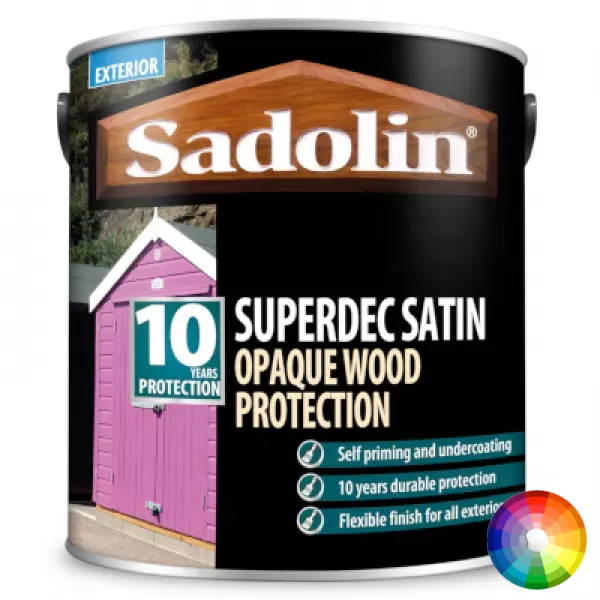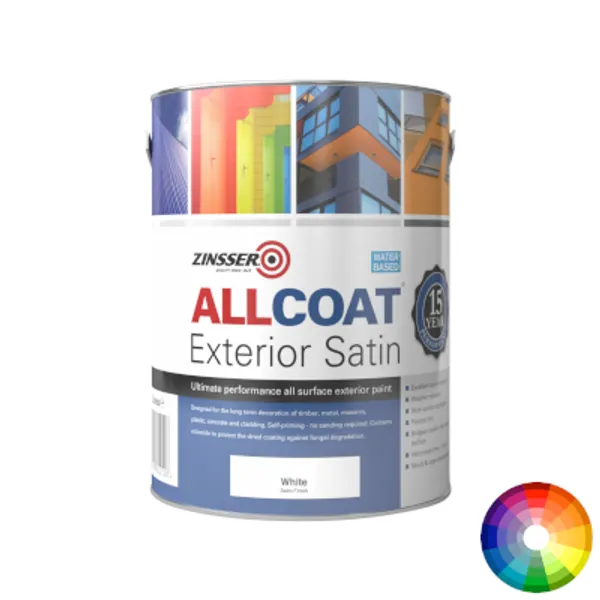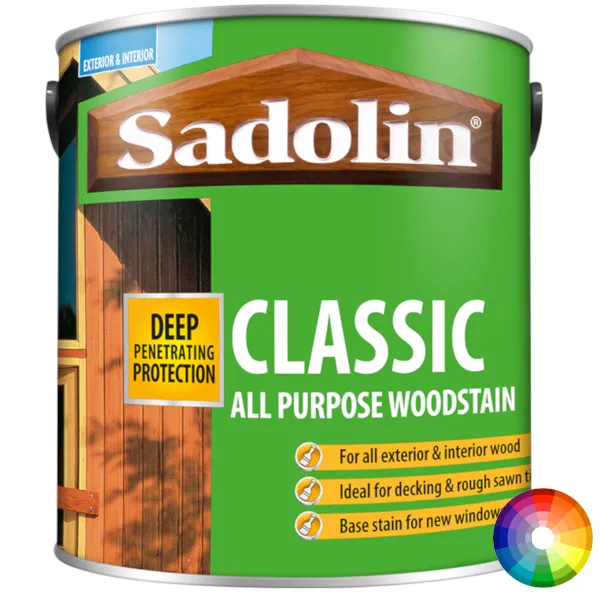The Best Fence Paints
We are often asked here at Painters World what is the best paint for fences? The answer is, it completely depends on what you are looking for, which is why our team of experts have put together this handy guide to fence paints so you can find out everything you need to know before you get painting!
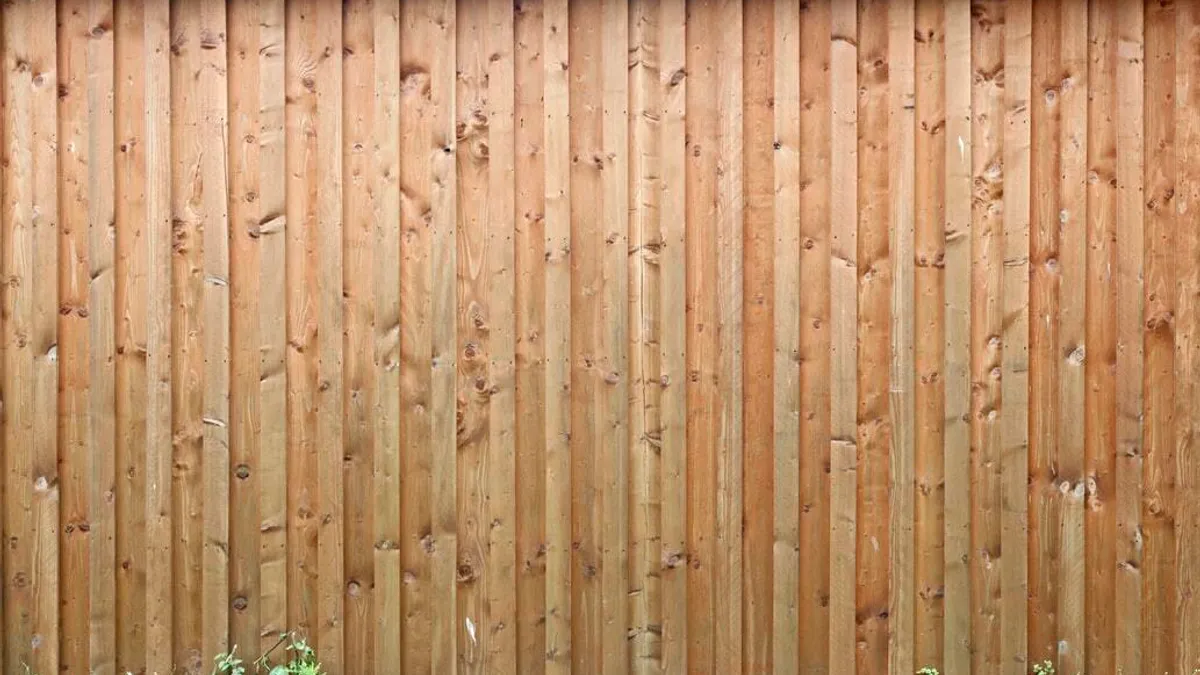
What Is Fence Paint?
Lets first establish what exactly fences are made of and what fence paint is. Garden fences come in a range of forms, from metal to wood. Generally speaking, people are looking to paint wooden garden fences, which is why we aren't going to cover metal paints in the guide. If you are interested in finding out what the best metal paints are, why not read our full guide to painting exterior metal?
When it comes to painting exterior wood such as wooden garden fences, there are a wide variety of treatments, including wood oil, wood varnish, woodstain & wood paint.
- Wood paint - refers to an opaque wood finish which completely cover the grain of the wood and give it a solid colour finish
- Woodstain - less 'solid' than paints, allowing the natural grain of the wood to be seen through the treatment, often available in a range of colours
- Wood varnish - a clear, tough and hardwearing coating that enhances the beauty of wood while also offering a protective layer
- Wood oil - nourishes and enhances the natural beauty of wood while being the easiest to maintain and repair
Identifying the wood treatment that best suits what you want to achieve is the very first step when decorating a garden fence. The two most popular choices are either a wood paint or a woodstain that are both designed to add colour to fences, rather than simply protecting them from the elements, although they do also provide this.
The Best Fence Paints
There are hundreds of wood treatments on the market for fences, which can make finding the best one extremely difficult. Luckily, our team of experts here at Painters World have had first hand experience over the course of 30 years with wood treatments, allowing them to give the very latest recommendations on the best paints to use.
Many of the paints on our recommendation list are examples of trade paints. You may be wondering, what exactly is trade paint? Well, the majority of paint manufacturers generally develop two versions of their paints, a retail version and a trade version. The trade version is higher quality, has better durability and offers a higher coverage, while the retail version is lower quality and comes with a smaller price tag because of this.
This is because a professional decorator must achieve consistently excellent results in as little time as possible, as the cost of having to apply three coats of paint instead of two can be significant. On the other hand, the average DIY'er is more price conscious and will generally want a cheaper paint that will get the job done.
The reality is however, that a poorer quality retail paint will not last as long and will take more coats to apply, which actually makes it poorer value for money than a trade paint. You do not have to be in the painting & decorating trade to buy a trade paint and it does not take more skill to apply. It will simply offer you a better finish, that will last much longer.
Here are our expert's picks for the best fence paints & stains.
The Best Fence Paint
1. Sadolin Superdec Opaque
At the top of the pile is when it comes to a wood paint for fences is Sadolin Superdec. This water-based paint for exterior wood is perfect for painting fences and any other exterior timber (except decking) thanks to its 10 year weather protection and its ability to remain flexible, allowing it to resist cracking, peeling & flaking. Sadolin Superdec is self-priming and undercoating, which makes it extremely easy to use and will create a complete colour transformation in just two coats, where other products may require three.
Aside from its fantastic performance, Sadolin Superdec can be mixed in almost any colour thanks to the paint mixing service here at Painters World. This includes RAL, British Standard or equivalent shades of all major manufacturers, even designer shades. We do not list all of the paints we can mix, which is why you can simply type in the name of the shade in our text box and we will mix an equivalent shade.
Advantages
- Can achieve a perfect finish
- 10 year durability
- Can be mixed in any colour
- Water-based - quick drying & ease to use
- Self-priming
Disadvantages
- Is slightly more expensive than other options on the market
- Not available in a matt finish
2. Zinsser Allcoat Exterior
While not a dedicated wood paint, Zinsser Allcoat is one of the most popular options for painting exterior wood as it can be applied to almost any exterior surface. It is a multi-coat paint that offers the ultimate flexibility to transform outdoor spaces. Not only can it be applied to almost any surface, it is available in matt, satin & gloss finishes and can be mixed in any colour. This gives you the opportunity to update all of your exterior surfaces using the same tin of paint, which can save money and time.
Another example of a water-based paint, Allcoat has fantastic performance with a 15 year lifespan, is self-priming like Sadolin Superdec and contains a biocide to protect the dried coating against fungal degradation.
The only difference in our expert's opinion between this and Sadolin Superdec is that Superdec will achieve a marginally nicer finish on wooden surfaces. Having said this, if you want a flat matt finish, Zinsser Allcoat is certainly the best fence paint for you as this is not available in Superdec!
Advantages
- 15 year durability
- Can be mixed in any colour
- Water-based - quick drying & ease to use
- Self-priming
- Can be applied to a range of other surfaces
Disadvantages
- Is slightly more expensive than other options on the market
- Not specifically designed for wood
3. Dulux Trade Ultimate Opaque
If you prefer an oil-based formulation, a fantastic exterior wood paint is Dulux Trade Ultimate Opaque, which offers a water-repellent finish for use on exterior timber. It has 10 year weather protection, fantastic opacity and all of the properties of an oil-based paint that some people prefer. Overall, it has a hardwearing and attractive finish, which would be our expert's pick for the best oil-based paint for fences.
Advantages
- 10 year durability
- Water repellent
- Can be mixed in any colour
- Oil-based paint
Disadvantages
- Only comes in a matt finish
- Has a longer drying time of 4-6 hours
The Best Fence Woodstain
Sadolin Classic
When it comes to a wood stain, our experts highly recommend Sadolin Classic. Sadolin Classic absorbs deeply into the timber, helping to provide protection against weathering by preventing rot. It has a coverage of 15 m2 per litre and prevents wood from fading by blocking UV light.
As it allows for the grain of the wood to still be seen, it offers a much more natural colour element to an outdoor space, maintaining some of the natural beauty of the wood while enhancing it with a colour of your choice. It comes in a range of popular neutral and earthy shades that are popular choices for exterior wood, such as Light Oak & Ebony, plus it can be mixed in a range of colour if you want to do something unique. When mixed in blues, greens, reds or any other strong colours, it has a softer look that can be more in keeping if you want to maintain a more rustic look.
Overall, it is a fantastic woodstain that is a go-to for many!
Advantages
- 10 year durability
- Can be mixed in a range of colours
- UV protection
- 15 m2 per litre coverage
- Excellent absorption
Disadvantages
- 16-24 hour recoat time
- Is more expensive than other woodstains on the market
The Best Fence Varnish
If you are looking for a clear varnish to apply to fences, we would recommend opting for Sadolin Yacht Varnish, which is a highly durable glossy wood varnish that can be used on exterior timber such as fences. Although a varnish is not as popular as wood paints or woodstains, if you want to simply enhance and protect your fencing, this is a great option.
Having said this, you can achieve a natural wood finish by using Sadolin Classic in a wood shade. This will also provide you with a less glossy finish than Sadolin Yacht Varnish.
Advantages
- Fantastic durability
- Clear protection
- High gloss finish
- UV protection
- 13 m2 per litre coverage
- Resists peeling or flaking
Disadvantages
- 16-24 hour recoat time
- A less popular choice of finish for fencing
How To Paint Fencing
Once you have decided on the best fence paint for you, it is time to discuss how exactly to apply it. The best time of year to do any exterior painting is in spring and summer, as you must have dry conditions to paint. Make sure you check the forecast and leave yourself enough time to fully complete the painting before the heavens open as this can completely derail the project.
You will need:
- Wood paint or woodstain
- Primer (if required)
- Paint brush or roller
- Paint tray or kettle
- Sandpaper
- Dust sheet
- Wire brush
- Paint scraper (if required)
Step 1: Preparation
The first step when painting any surface is to properly prepare it, as this is the key to long-lasting results.
Begin by covering any plants and other objects underneath the fencing using a dust sheet.
If the fence has been previously painted and there is peeling or flake paint, remove this using a paint scraper.
Next, clean down the fences first with a wire brush, to remove any large dirt and debris from the surface. Once large dirt has been removed, you may want to use a pressure washer or a garden hose to wash down the fence. This will ensure the best possible finish. Leave the wood to completely dry before moving on.
Once the fence is clean, you can it sand them down using sandpaper to create the smoothest possible surface to paint. Focus on the roughest sections where any splinters are present. Once completed, brush the fence down to remove any dust that will prevent the paint from adhering.
Step 2: Priming
Depending on the paint you are using, you may require a primer or an undercoat. Primers are very thin and usually colourless, allowing you to apply a layer using a brush or roller quickly & easily. Only one coat of primer is required.
An undercoat is a neutral base that is applied to surfaces to cover imperfections and allow topcoats to build colour on top of. Generally, paints will have a dedicated undercoat with their topcoat, which we recommend using together.
If you are using Sadolin Superdec, Zinsser Allcoat or any other self-priming product, you do not need to apply a primer or an undercoat.
Step 3: Painting
Now the important part, the painting. Ensuring you use the best tools will be dividends, trust us! It doesn't matter whether you prefer using a paint brush or a paint roller, you can use either for this. The best roller for painting fences is something small and easy to control, which makes a mini-roller the best option. We would go for the 4" Hamilton Prestige Mini Frame with a 4" Hamilton Perfection Medium Pile Roller, which is a fantastic roller that will last you years if you take care of it. When it comes to a paint brush, we'd recommend the 4" Hamilton Timbercare Brush, which is perfect for painting a large timber surface like fencing, quickly and effectively.
Once you have your tools at the ready, start at the top of the fence, working your brush or roller in the same direction of the grain. Once you have applied your first full coat of wood paint or stain, allow this to completely dry as per the manufacturers instructions.
Repeat the process again with your second coat, applying this slightly thicker than you first coat but while ensuring that you do not cause on drips of paint.
Once your two coats of paint or satin have been applied, you are finished! You can then clean your brushes & roller using water if you used a water-based paint, or white spirit if you used an oil-based paint.
Frequently Asked Questions
Q. How much fence paint do I need?
Estimating the amount of paint you will need for any decorating project can be difficult. You need to know three things when estimating this; the coverage of the paint you are using, the size of the area and the number of coats required.
The coverage of the paint you are using and the coats required is the easiest part of the equation. This can be easily found on the manufacturers instructions. Generally, fence paints or stains have a coverage of between 10-15m2 per litre and require two coats. This means that on a conservative estimate, a 5L tin of paint will cover 25m2 in two coats.
Next, find the size of the fencing you are painting. You can do this by measuring the total length of all of your fencing and multiplying it by the height of the fence. If you have a 1 metre tall fence that spans 25 metres, this will give you a total area of 25m2 to paint.
Based on this calculation, a 5L tin of paint would be perfect for the project. Remember, it is always better to overestimate how much paint you will need as having some spare can be handy for any touch ups. Furthermore, if you buy a multi-surface paint like Zinsser Allcoat, you can use the rest of the paint for smaller projects too!
Q. Can fence paint be used on decking?
If you have a bit of spare paint left, it can often be tempting to see what else you can use it for. The problem with painting decking however is that this is not the average surface. Many wood paints do not include decking in their guarantees or warranties as it is much more likely for a paint or stain to fail on decking when compared to a vertical surface like a fence. This is because footfall and standing water both attack the treatment, causing it to fail.
There is a woodstain that we highly recommend that could be applied to both fencing and decking, which is Sadolin Beautiflex Solvent Opaque Woodstain. This is a woodstain that has the necessary properties to be applied to a floored timber surface, although its 7 year lifespan applies to any wooden surface, except decking.
Q. Is fence paint water based?
A large majority of fence paints are water-based today due to the increasing quality of water-based technology compared to oil-based technology. There are a number of oil/solvent-based paints that can be applied to fences if this is your preference however.
Q. Is fence paint waterproof?
Fence paint, as with any exterior paint, must have a level of weather protection due to the moisture they must endure, especially when used here in the UK. Having said this, there are very few products that can be considered waterproof, as this requires a level of water repellency.
Dulux Trade Ultimate Opaque is an example of a water repellent fence paint, while other options on the market provide weather resistance.
Fence Paint Colours
It is always worth exploring your options and taking a look at some inspiration when painting anything as the options are endless! Here are a few examples of garden fence projects that we absolutely love.
1. Grey
Whether you opt for a dark grey or a light grey, the results can be beautiful. Greys are hugely popular at the moment for exterior use and for good reason. They are hugely versatile, can work in any colour scheme and just give the most wonderful clean and modern look to a garden. Shades such as anthracite grey & light grey in particular are the go-to colours across the the UK currently.
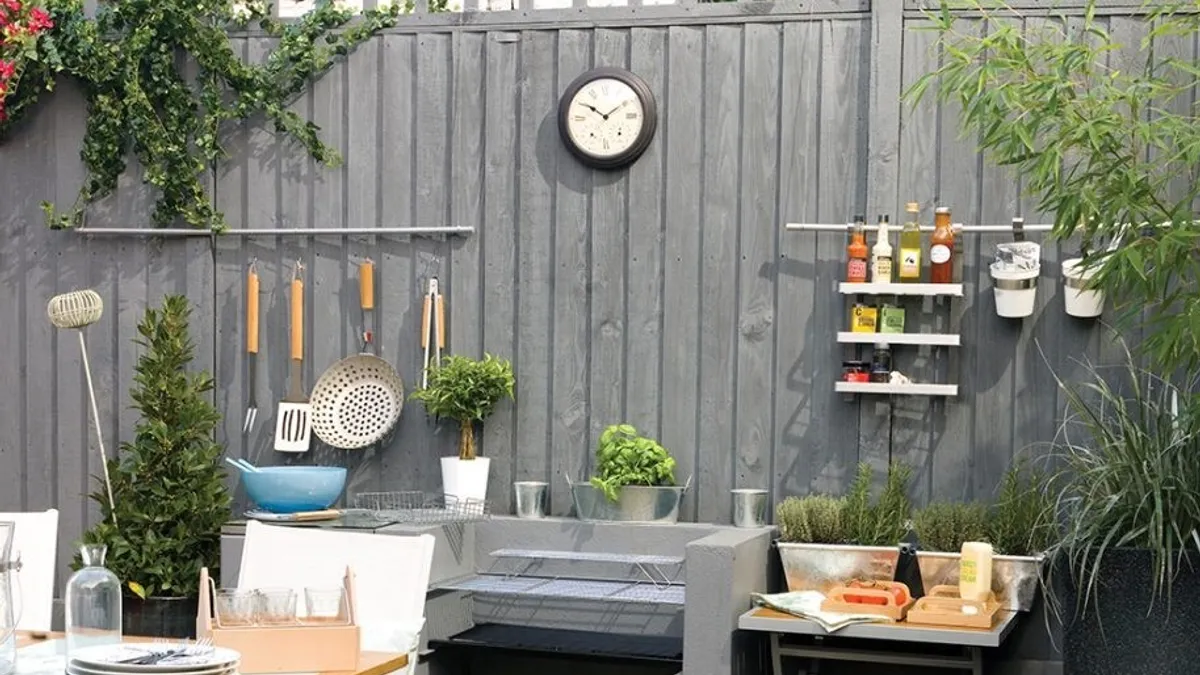
2. Go Colourful!
While a simple look can be effective, many of us want our gardens to stand out from the crowd. There is no better way to do that then to add some colour to your fences. The beauty of colour is that it gives an outdoor space life, a fresh feel & can completely transform even the smallest garden. If you can't decide on just one colour, you could create an ombre effect on your fence panels by picking 3 or 4 shades on the same colour palette.
Don't be afraid of colour, there are so many opportunities to express yourself!
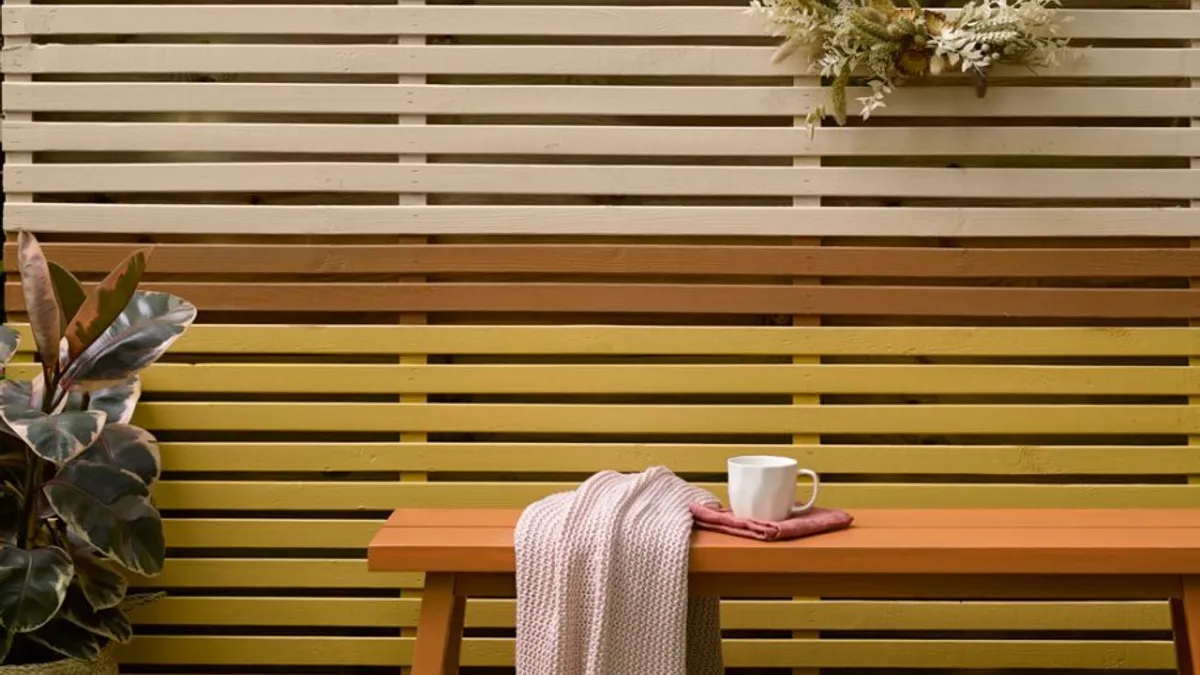
3. Black
Black is a shade people are very wary of. They think it can be too dark and can have a heavy effect on an outdoor space, when a garden should be light and joyous. While that rings true in some cases, black when used in the right circumstances can be ultra-modern, clean & quite simply beautiful. The use of darker shades is very on-trend at the moment all over the home because of their ability to suit any space. Blacks come in more forms than you think, from a dark jet black to a lighter black grey, or even a black with a blue tone in it. We absolutely love them!

We hope this has answered any questions you may have had regarding the the best fence paint in the UK and how to apply it. If you require any more help, just send an email to hello@paintersworld.co.uk and our expert team will be on hand to give you any advice you require. At Painters World we have a wide range of paints available, so no matter the job, we've got the right tools for you.



Sign up now and be the first to know about exclusive offers, product updates, and announcements.

